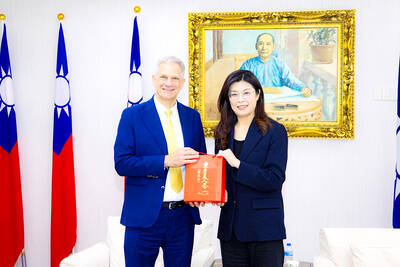It’s Sunday morning and Brazilian surfer Gabriel Gras is closely watching the waves breaking on Dulan (都蘭) beach of Taiwan’s southeastern coast. “I’m looking for something that is hollow and [tubular],” he says.
For the 28-year-old language teacher, sacrificing a Sunday lie-in for a chance to hit the sea is worth it. “When you catch a really good wave it feels like time slows down, you aren’t thinking about anything, you’re just reacting to the ocean moment by moment.”
Gras, resident of the nearby coastal town of Donghe (東河), is among a small but growing crowd of surfers who have come to Taitung County as rumors spread about the region’s waves.

Photo: Sam Sky Wild
On Saturday night, the Wa Ga Li Gong guesthouse is filled with travelers, and the slightly overworked-looking co-owner, Tienie Wessels from South Africa, is busy pouring pints and dispatching food. The bar area is bedecked with surf-inspired artwork and an area around the back is stuffed with boards.
“I’ve been surfing in Taiwan since I first arrived here 13 years ago,” Wessels says while mixing a cocktail. “Back then [in Yilan] there were ten people in the water and now there are hundreds … When we first came no one really knew about it but now people are coming specifically for the surf.”
Taitung is still off the beaten track, but it’s slowly gaining a reputation. “You can’t compare it to Indonesia for example — you don’t have the consistency of waves here — but you have got space in the water,” he says.

Photo: Sam Sky Wild
Slow start
Fellow South African expat and business partner, Mark Jackson, joins the discussion. “It’s weird, but the more affluent city people caught on to surfing before [Taitung] locals did, so Dulan has very few surfers,” he says.
Jackson’s bountiful energy — much of which he pours into his love of wind-surfing — masks the serious side of the guesthouse proprietor and aspiring film-maker. He has spent much time studying the history of Taiwan’s all-encompassing sea border.

Photo: Sam Sky Wild
“Martial Law made it impossible to surf,” he says. “And there was a huge stigma around the beach — the whole idolization of white skin where the sun is the enemy. But you also have to remember that the bunkers you can see on the beaches were in use until recently. There was also a mental frontier — years back going to the beach would have been like [an American] going to the frontier with Mexico during the Alamo!”
Academic research appears to support Jackson. In “Leisure Governance In Transition: The Case of Taiwan,” National Taiwan University of Arts professor Liu Chun-yu (劉俊裕) writes that “leisure activities and policy in Taiwan during the 1960s … were very much confined by Martial Law, which was enacted to secure the island … The government promulgated a set of regulations controlling … coastal districts and bathing beach areas.”
After the lifting of Martial Law, travel restrictions were dismantled and leisure activities became more multifaceted, according to Liu.
He and other academics also point to growing levels of disposable income and the introduction of regulations extending weekend holidays in 1998 as key to the growing interest among Taiwanese in coastal leisure pursuits.
Surf Economy
William Chen (陳仁傑), a 37-year-old Yilan native, says he took to the waves five years ago because a friend wanted to do “something cool on the beach.”
Chen was hooked instantly. “The first time I took off successfully it was so peaceful — I felt like I was standing on a cloud flying over the sea. I loved that feeling.”
The marketing executive has traded in his well-paid Taipei job to become an organic rice farmer. He now balances the needs of his Taitung-based firm “Surfer Rice” with regular trips to the nearby ocean.
As the wave of surfing enterprise continues to build strength, others have jumped on board. Amis Aboriginal Hana Lee runs brisk business at her Dulan-based surf shop, where she also offers surfing lessons.
“I’m a surfer and a housekeeper,” Lee says proudly. “I’m happy, it’s fantastic — I’m so excited when I can do a new trick or stunt, it’s even better than making money,” she says.
Three months pregnant with her second child, Lee continues to surf with her long-board and is resolved to carry on while she can. Her determination has cost her in the past, however, and a deep crimson scar — from encountering a bluebottle jellyfish — cuts across the top of her right arm. And even bigger foes may be lurking. Last November, a 4.5-meter-long Great White Shark was caught near Taitung’s increasingly popular Surf Comp.
However, most surfers remain indifferent to potential perils. “I haven’t given up,” says Lee, “I just chase smaller waves now.”
Baybay Niu (鈕臻琳), the only officially-sponsored Taiwanese female surfer who lives in Taitung’s unofficial surfing Mecca, Donghe, also has no plans to quit.
The 38-year-old, who has been surfing for 11 years, regularly competes against men at international events representing Taiwan. She says her goal now is to help grow local talent in Taitung.
“Kids here were brought up with the ocean and I’m teaching a lot of Aboriginal children to surf so that they will start earlier than me and become world class surfers,” she says.

Seven hundred job applications. One interview. Marco Mascaro arrived in Taiwan last year with a PhD in engineering physics and years of experience at a European research center. He thought his Gold Card would guarantee him a foothold in Taiwan’s job market. “It’s marketed as if Taiwan really needs you,” the 33-year-old Italian says. “The reality is that companies here don’t really need us.” The Employment Gold Card was designed to fix Taiwan’s labor shortage by offering foreign professionals a combined resident visa and open work permit valid for three years. But for many, like Mascaro, the welcome mat ends at the door. A

Last week gave us the droll little comedy of People’s Republic of China’s (PRC) consul general in Osaka posting a threat on X in response to Japanese Prime Minister Sanae Takaichi saying to the Diet that a Chinese attack on Taiwan may be an “existential threat” to Japan. That would allow Japanese Self Defence Forces to respond militarily. The PRC representative then said that if a “filthy neck sticks itself in uninvited, we will cut it off without a moment’s hesitation. Are you prepared for that?” This was widely, and probably deliberately, construed as a threat to behead Takaichi, though it

If China attacks, will Taiwanese be willing to fight? Analysts of certain types obsess over questions like this, especially military analysts and those with an ax to grind as to whether Taiwan is worth defending, or should be cut loose to appease Beijing. Fellow columnist Michael Turton in “Notes from Central Taiwan: Willing to fight for the homeland” (Nov. 6, page 12) provides a superb analysis of this topic, how it is used and manipulated to political ends and what the underlying data shows. The problem is that most analysis is centered around polling data, which as Turton observes, “many of these

Since Cheng Li-wun (鄭麗文) was elected Chinese Nationalist Party (KMT) chair on Oct. 18, she has become a polarizing figure. Her supporters see her as a firebrand critic of the ruling Democratic Progressive Party (DPP), while others, including some in her own party, have charged that she is Chinese President Xi Jinping’s (習近平) preferred candidate and that her election was possibly supported by the Chinese Communist Party’s (CPP) unit for political warfare and international influence, the “united front.” Indeed, Xi quickly congratulated Cheng upon her election. The 55-year-old former lawmaker and ex-talk show host, who was sworn in on Nov.